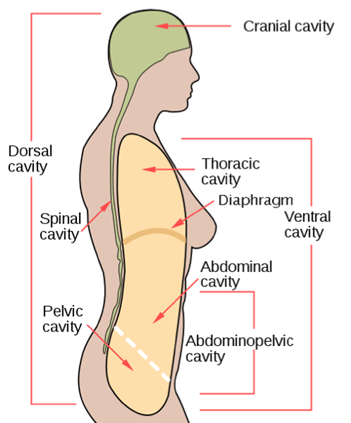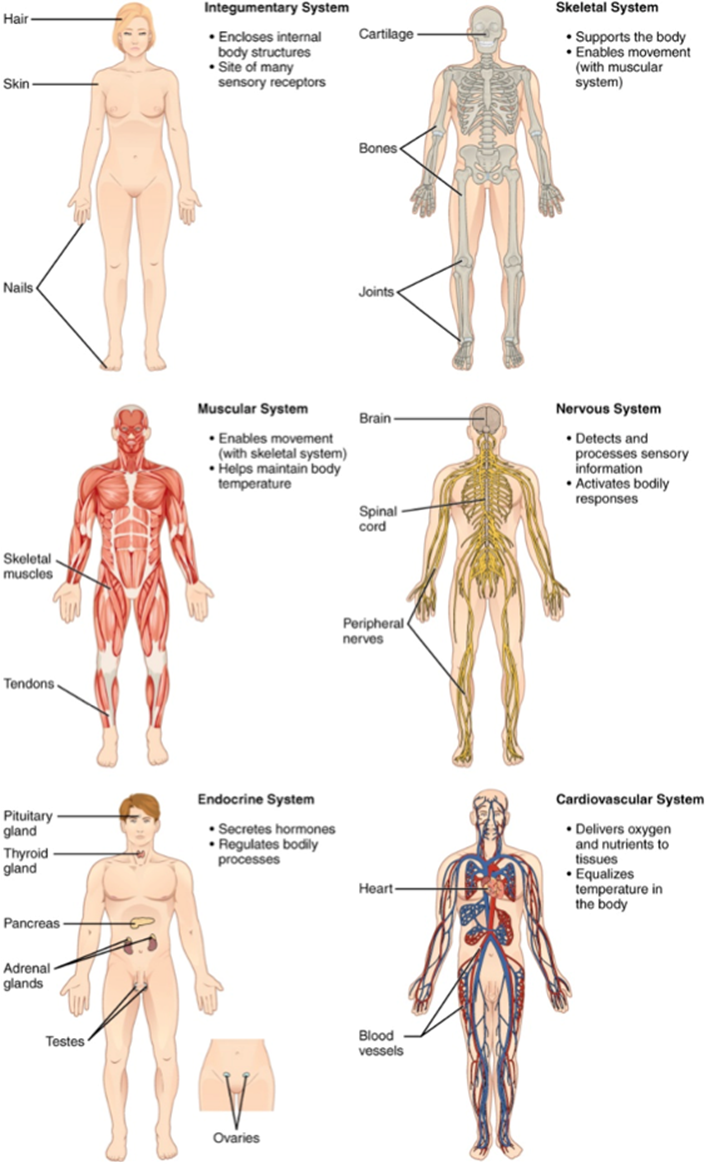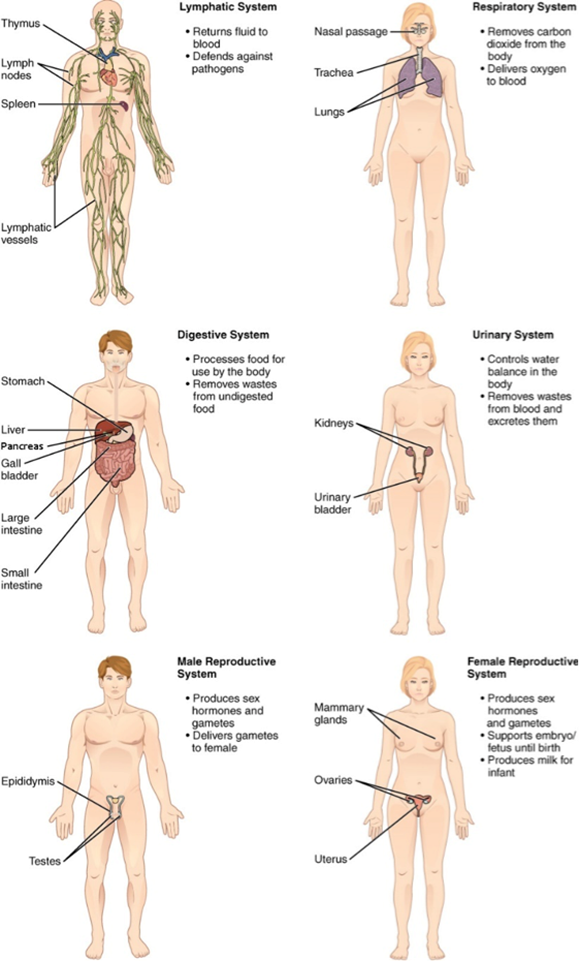1.3: Human Body Cavities and Organ Systems
- Page ID
- 52718
\( \newcommand{\vecs}[1]{\overset { \scriptstyle \rightharpoonup} {\mathbf{#1}} } \)
\( \newcommand{\vecd}[1]{\overset{-\!-\!\rightharpoonup}{\vphantom{a}\smash {#1}}} \)
\( \newcommand{\id}{\mathrm{id}}\) \( \newcommand{\Span}{\mathrm{span}}\)
( \newcommand{\kernel}{\mathrm{null}\,}\) \( \newcommand{\range}{\mathrm{range}\,}\)
\( \newcommand{\RealPart}{\mathrm{Re}}\) \( \newcommand{\ImaginaryPart}{\mathrm{Im}}\)
\( \newcommand{\Argument}{\mathrm{Arg}}\) \( \newcommand{\norm}[1]{\| #1 \|}\)
\( \newcommand{\inner}[2]{\langle #1, #2 \rangle}\)
\( \newcommand{\Span}{\mathrm{span}}\)
\( \newcommand{\id}{\mathrm{id}}\)
\( \newcommand{\Span}{\mathrm{span}}\)
\( \newcommand{\kernel}{\mathrm{null}\,}\)
\( \newcommand{\range}{\mathrm{range}\,}\)
\( \newcommand{\RealPart}{\mathrm{Re}}\)
\( \newcommand{\ImaginaryPart}{\mathrm{Im}}\)
\( \newcommand{\Argument}{\mathrm{Arg}}\)
\( \newcommand{\norm}[1]{\| #1 \|}\)
\( \newcommand{\inner}[2]{\langle #1, #2 \rangle}\)
\( \newcommand{\Span}{\mathrm{span}}\) \( \newcommand{\AA}{\unicode[.8,0]{x212B}}\)
\( \newcommand{\vectorA}[1]{\vec{#1}} % arrow\)
\( \newcommand{\vectorAt}[1]{\vec{\text{#1}}} % arrow\)
\( \newcommand{\vectorB}[1]{\overset { \scriptstyle \rightharpoonup} {\mathbf{#1}} } \)
\( \newcommand{\vectorC}[1]{\textbf{#1}} \)
\( \newcommand{\vectorD}[1]{\overrightarrow{#1}} \)
\( \newcommand{\vectorDt}[1]{\overrightarrow{\text{#1}}} \)
\( \newcommand{\vectE}[1]{\overset{-\!-\!\rightharpoonup}{\vphantom{a}\smash{\mathbf {#1}}}} \)
\( \newcommand{\vecs}[1]{\overset { \scriptstyle \rightharpoonup} {\mathbf{#1}} } \)
\( \newcommand{\vecd}[1]{\overset{-\!-\!\rightharpoonup}{\vphantom{a}\smash {#1}}} \)
\(\newcommand{\avec}{\mathbf a}\) \(\newcommand{\bvec}{\mathbf b}\) \(\newcommand{\cvec}{\mathbf c}\) \(\newcommand{\dvec}{\mathbf d}\) \(\newcommand{\dtil}{\widetilde{\mathbf d}}\) \(\newcommand{\evec}{\mathbf e}\) \(\newcommand{\fvec}{\mathbf f}\) \(\newcommand{\nvec}{\mathbf n}\) \(\newcommand{\pvec}{\mathbf p}\) \(\newcommand{\qvec}{\mathbf q}\) \(\newcommand{\svec}{\mathbf s}\) \(\newcommand{\tvec}{\mathbf t}\) \(\newcommand{\uvec}{\mathbf u}\) \(\newcommand{\vvec}{\mathbf v}\) \(\newcommand{\wvec}{\mathbf w}\) \(\newcommand{\xvec}{\mathbf x}\) \(\newcommand{\yvec}{\mathbf y}\) \(\newcommand{\zvec}{\mathbf z}\) \(\newcommand{\rvec}{\mathbf r}\) \(\newcommand{\mvec}{\mathbf m}\) \(\newcommand{\zerovec}{\mathbf 0}\) \(\newcommand{\onevec}{\mathbf 1}\) \(\newcommand{\real}{\mathbb R}\) \(\newcommand{\twovec}[2]{\left[\begin{array}{r}#1 \\ #2 \end{array}\right]}\) \(\newcommand{\ctwovec}[2]{\left[\begin{array}{c}#1 \\ #2 \end{array}\right]}\) \(\newcommand{\threevec}[3]{\left[\begin{array}{r}#1 \\ #2 \\ #3 \end{array}\right]}\) \(\newcommand{\cthreevec}[3]{\left[\begin{array}{c}#1 \\ #2 \\ #3 \end{array}\right]}\) \(\newcommand{\fourvec}[4]{\left[\begin{array}{r}#1 \\ #2 \\ #3 \\ #4 \end{array}\right]}\) \(\newcommand{\cfourvec}[4]{\left[\begin{array}{c}#1 \\ #2 \\ #3 \\ #4 \end{array}\right]}\) \(\newcommand{\fivevec}[5]{\left[\begin{array}{r}#1 \\ #2 \\ #3 \\ #4 \\ #5 \\ \end{array}\right]}\) \(\newcommand{\cfivevec}[5]{\left[\begin{array}{c}#1 \\ #2 \\ #3 \\ #4 \\ #5 \\ \end{array}\right]}\) \(\newcommand{\mattwo}[4]{\left[\begin{array}{rr}#1 \amp #2 \\ #3 \amp #4 \\ \end{array}\right]}\) \(\newcommand{\laspan}[1]{\text{Span}\{#1\}}\) \(\newcommand{\bcal}{\cal B}\) \(\newcommand{\ccal}{\cal C}\) \(\newcommand{\scal}{\cal S}\) \(\newcommand{\wcal}{\cal W}\) \(\newcommand{\ecal}{\cal E}\) \(\newcommand{\coords}[2]{\left\{#1\right\}_{#2}}\) \(\newcommand{\gray}[1]{\color{gray}{#1}}\) \(\newcommand{\lgray}[1]{\color{lightgray}{#1}}\) \(\newcommand{\rank}{\operatorname{rank}}\) \(\newcommand{\row}{\text{Row}}\) \(\newcommand{\col}{\text{Col}}\) \(\renewcommand{\row}{\text{Row}}\) \(\newcommand{\nul}{\text{Nul}}\) \(\newcommand{\var}{\text{Var}}\) \(\newcommand{\corr}{\text{corr}}\) \(\newcommand{\len}[1]{\left|#1\right|}\) \(\newcommand{\bbar}{\overline{\bvec}}\) \(\newcommand{\bhat}{\widehat{\bvec}}\) \(\newcommand{\bperp}{\bvec^\perp}\) \(\newcommand{\xhat}{\widehat{\xvec}}\) \(\newcommand{\vhat}{\widehat{\vvec}}\) \(\newcommand{\uhat}{\widehat{\uvec}}\) \(\newcommand{\what}{\widehat{\wvec}}\) \(\newcommand{\Sighat}{\widehat{\Sigma}}\) \(\newcommand{\lt}{<}\) \(\newcommand{\gt}{>}\) \(\newcommand{\amp}{&}\) \(\definecolor{fillinmathshade}{gray}{0.9}\)Information
The major cavities of the human body are the spaces left over when internal organs are removed. There are additional body cavities which we will only discuss in lecture. These are the cavities created by serous membranes–the pleural cavities, the pericardial cavity, and the peritoneal cavity–and the mediastinum.
- Dorsal body cavity–the cranial cavity and the spinal cavity in combination.
- Cranial cavity–the space occupied by the brain, enclosed by the skull bones.
- Spinal cavity–the space occupied by the spinal cord enclosed by the vertebrae column making up the backbone. The spinal cavity is continuous with the cranial cavity.
- Ventral body cavity–the thoracic cavity, the abdominal cavity, and the pelvic cavity in combination.
- Thoracic cavity–the space occupied by the ventral internal organs superior to the diaphragm.
- Abdominopelvic cavity–the abdominal cavity and the pelvic cavity in combination.
- Abdominal cavity–the space occupied by the ventral internal organs inferior to the diaphragm and superior to the pelvic cavity.

- Pelvic cavity–the space occupied by the ventral internal organs that are bordered by the bones of the pelvic girdle.
LAB EXERCISE 1-3
Fill in the blank with the appropriate body cavity
1. The two main body cavities are the ________ __________and the _________ _________cavities.
2. The stomach is found in the _________ _________cavity.
3. The heart is found in the cavity, which is part of the larger cavity.
4. The brain is found within the cavity which is part of the larger cavity
5. The urinary bladder and reproductive organs are found within the _________ _________ cavity.
LICENSES AND ATTRIBUTIONS
CC LICENSED CONTENT, ORIGINAL
A&P labs. Authored by: Ross Whitwam. Provided by: Mississippi University for Women. Located at: http://www.muw.edu/. License: CC BY-SA: Attribution-ShareAlike
CC LICENSED CONTENT, SHARED PREVIOUSLY
Figure \(\PageIndex{1}\). The locations of the major body cavities of the human body.. Authored by: Mysid. Provided by: Wikipedia. Located at: https://commons.wikimedia.org/wiki/F...avities-en.svg. License: Public Domain: No Known Copyright
The Human Organ Systems
Information
Organ systems are groups of organs within the body that can be thought of as working together as a unit to carry out specific tasks or functions within the body. The human body is most commonly divided into eleven organ systems, the ones listed below.
It should be kept in mind that these divisions are somewhat arbitrary as to which organs are included and which are excluded. Skeletal muscles attached to bones are part of the muscular system, but the smooth muscles around soft tissues are not. Skeletal muscles are attached to bones, and serve to move the bones, but bones are part of the skeletal system, not the muscular system.
It also bears remembering that no one organ system ever functions independently of the others. The nervous system sends instructions to the muscular system as to when to move particular muscles. The cardiovascular system delivers nutrients and removes wastes from the muscle fibers of the muscular system to allow them to continue to function, etc. Dividing the human body into eleven organ systems is simply a way for the human mind to organize information about what parts do what. In the body itself, the parts that need to interact do interact, regardless of which system they have been grouped into.
The eleven organ systems are shown in Figure \(\PageIndex{2}\). The figure also lists the organs in each system and some roles for each system.

Figure \(\PageIndex{2}\): Organs that work together are grouped into organ systems. (CC-BY, Open Stax)

Identifying the major internal organs of the body
LAB 1 EXERCISE \(\PageIndex{1}\)
For each of the following organs, identify the organ system to which it belongs. There are three organs in this list which each belong to two organ systems; in those cases, list them both.
|
Brain |
|
Ovaries |
|
|
Cartilage |
|
Pancreas |
|
|
Skin |
|
Spleen |
|
|
Heart |
|
Kidneys |
|
|
Lungs |
|
Testes |
|
|
Mammary glands |
|
Gall bladder |
|
|
Thymus |
|
Pituitary gland |
|
CC LICENSED CONTENT, ORIGINAL
A&P Labs. Authored by: Ross Whitwam. Provided by: Mississippi University for Women. Located at: . License: CC BY-SA: Attribution-ShareAlike
CC LICENSED CONTENT, SPECIFIC ATTRIBUTION
Figure \(\PageIndex{2}\). Organ Systems, part 1.. Provided by: OpenStax College. Located at: https://cnx.org/resources/9470e72cca...ody(Page1).jpg. Proje ct: Anatomy & Physiology . License: CC BY-SA: Attribution-ShareAlike
Figure \(\PageIndex{2}\). Organ Systems, part 2.. Provided by: OpenStax College. Locate at: https://cnx.org/resources/9490de5610...ody(Page2).jpg. Licen se: CC BY-SA: Attribution-ShareAlike

